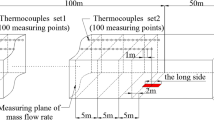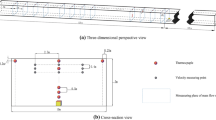Abstract
This paper systematically studied the coupling effect of ambient pressure and tunnel slope on temperature distribution and smoke propagation in full-scale tunnel fires under natural ventilation by FDS. The downstream length (longitudinal length from fire source center to tunnel downstream exit) was also considered. The concept of “height difference of stack effect” was put forward when analyzing the mutual effect of tunnel slope and downstream length on smoke movement. The results show that the maximum smoke temperature beneath the ceiling decreases with the increasing ambient pressure or tunnel slope. The longitudinal smoke temperature decays faster with the decreasing ambient pressure or slope in inclined tunnel. The induced inlet airflow velocity increases with the increasing height difference of stack effect, while decreases with the increasing ambient pressure. And the smoke backlayering length decreases with the increasing height difference of stack effect. Taking heat release rate (HRR), ambient pressure, tunnel slope and downstream length into account, the prediction models of dimensionless induced inlet airflow velocity and smoke backlayering length in inclined tunnel fires at high altitude were developed, which agree well with our and others’ results. The outcomes of current study are great meaningful to fire detection and smoke control in inclined tunnel fires at high altitude.












Similar content being viewed by others
Data Availability
The data and materials used and analyzed during the current study are available from the corresponding author on reasonable request.
References
Duan YL, Wang S, Wang WH, Zheng K (2020) Atmospheric disturbance on the gas explosion in closed fire zone. Int J Coal Sci Technol 7(4):752–765. https://doi.org/10.1007/s40789-020-00295-3
Fan CG, Ji J, Wang W, Sun JH (2014) Effects of vertical shaft arrangement on natural ventilation performance during tunnel fires. Int J Heat Mass Transf 73:158–169. https://doi.org/10.1016/j.ijheatmasstransfer.2014.02.003
Fan CG, Li XY, Mu Y, Guo FY, Ji J (2017) Smoke movement characteristics under stack effect in a mine laneway fire. Appl Therm Eng 110:70–79. https://doi.org/10.1016/j.applthermaleng.2016.08.120
Fan CG, Luan D, Bu RW, Sheng ZQ, Wang FY, Huang XY (2023) Can heavy rainfall affect the burning and smoke spreading characteristics of fire in tunnels. Int J Heat Mass Transf 207:123972. https://doi.org/10.1016/j.ijheatmasstransfer.2023.123972
Gao ZH, Li LJ, Zhong W, Liu X (2021) Characterization and prediction of ceiling temperature propagation of thermal plume in confined environment of common services tunnel. Tunn Undergr Space Technol 110:103714. https://doi.org/10.1016/j.tust.2020.103714
Gao ZH, Li LJ, Sun CP, Zhong W, Yan CB (2022) Effect of longitudinal slope on the smoke propagation and ceiling temperature characterization in sloping tunnel fires under natural ventilation. Tunn Undergr Space Technol 123:104396. https://doi.org/10.1016/j.tust.2022.104396
Gannouni S, Maad RB (2015) Numerical study of the effect of blockage on critical velocity and backlayering length in longitudinally ventilated tunnel fires. Tunn Undergr Space Technol 48:147–155. https://doi.org/10.1016/j.tust.2015.03.003
Gannouni S (2022) Critical velocity for preventing thermal backlayering flow in tunnel fire using longitudinal ventilation system: Effect of floor-fire separation distance. Int J Therm Sci 171:107192. https://doi.org/10.1016/j.ijthermalsci.2021.107192
Guo FY, Gao ZH, Wan HX, Ji J, Yu LX, Ding L (2019) Influence of ambient pressure on critical ventilation velocity and backlayering distance of thermal driven smoke in tunnels with longitudinal ventilation. Int J Therm Sci 145:105989. https://doi.org/10.1016/j.ijthermalsci.2019.105989
Haack A (2002) Current safety issues in traffic tunnels. Tunnell Undergr Space Technol Incorp Trench Technol Res 17:117–127. https://doi.org/10.1016/S0886-7798(02)00013-5
Hu LH, Huo R, Wang HB, Li YZ, Yang RX (2007) Experimental studies on fireinduced buoyant smoke temperature distribution along tunnel ceiling. Build Environ 42:3905–3915. https://doi.org/10.1016/j.buildenv.2006.10.052
Hu LH, Chen LF, Wu L, Li YF, Zhang JY, Meng N (2013) An experimental investigation and correlation on buoyant gas temperature below ceiling in a slopping tunnel fire. Appl Therm Eng 51:246–254. https://doi.org/10.1016/j.applthermaleng.2012.07.043
Ji J, Bi YB, Venkatasubbaiah K, Li KY (2016) Influence of aspect ratio of tunnel on smoke temperature distribution under ceiling in near field of fire source. Appl Therm Eng 106:1094–1102. https://doi.org/10.1016/j.applthermaleng.2016.06.086
Ji J, Guo FY, Gao ZH, Zhu JP, Sun JH (2017) Numerical investigation on the effect of ambient pressure on smoke movement and temperature distribution in tunnel fires. Appl Therm Eng 118:663–669. https://doi.org/10.1016/j.applthermaleng.2017.03.026
Ji J, Wang ZY, Ding L, Yu LX, Gao ZH, Wan HX (2019) Effects of ambient pressure on smoke movement and temperature distribution in inclined tunnel fires. Int J Therm Sci 145:106006. https://doi.org/10.1016/j.ijthermalsci.2019.106006
Kashef A, Yuan ZY, Lei B (2013) Ceiling temperature distribution and smoke diffusion in tunnel fires with natural ventilation. Fire Saf J 62:249–255. https://doi.org/10.1016/j.firesaf.2013.09.019
Ko YJ, Hadjisophocleous GV (2013) Study of smoke backlayering during suppression in tunnels. Fire Saf J 58:240–247. https://doi.org/10.1016/j.firesaf.2013.03.001
Kong J, Xu ZS, You WJ, Wang BL, Liang Y, Chen T (2021) Study of smoke back-layering length with different longitudinal fire locations in inclined tunnels under natural ventilation. Tunn Undergr Space Technol 107:103663. https://doi.org/10.1016/j.tust.2020.103663
Kong J, You WJ, Xu ZS, Liu H, Li HH (2022) A numerical study on smoke behaviors in inclined tunnel fires under natural ventilation. J Saf Sci Resilie 3(2):169–178. https://doi.org/10.1016/j.jnlssr.2022.01.003
Li YZ, Lei B, Ingason H (2010) Study of critical velocity and backlayering length in longitudinally ventilated tunnel fires. Fire Saf J 45:361–370. https://doi.org/10.1016/j.firesaf.2010.07.003
Liu B, Mao J, Xi YH, Hu JW (2021) Effects of altitude on smoke movement velocity and longitudinal temperature distribution in tunnel fires. Tunn Undergr Space Technol 112:103850. https://doi.org/10.1016/j.tust.2021.103850
Merci B (2008) One-dimensional analysis of the global chimney effect in the case of fire in an inclined tunnel. Fire Saf J 43:376–389. https://doi.org/10.1016/j.firesaf.2007.09.003
Mcgrattan KB, Mcdermott RJ, Weinschenk CG, Forney GP (2013) Fire Dynamics Simulator. In: User’s Guide. Nist Special Publication. https://doi.org/10.6028/NIST.sp.1019
Oka Y, Kakae N, Imazeki O, Inagaki K (2013) Temperature property of ceiling jet in an inclined tunnel. Proc Eng 62:234–241. https://doi.org/10.1016/j.proeng.2013.08.060
Oka Y, Oka H (2016) Velocity and temperature attenuation of a ceiling-jet along a horizontal tunnel with a flat ceiling and natural ventilation. Tunn Undergr Space Technol 56:79–89. https://doi.org/10.1016/j.tust.2016.03.001
Roh JS, Ryou HS, Kim DH, Jung WS, Jang YJ (2007) Critical velocity and burning rate in pool fire during longitudinal ventilation. Tunn Undergr Space Technol 22:262–271. https://doi.org/10.1016/j.tust.2006.08.003
Shi CL, Zhong MH, Chen CK, Jiao WB, Li J, Zhang YL, Zhang L, Li Y, He L (2020) Metro train carriage combustion behaviors–Full-scale experiment study. Tunn Undergr Space Technol 104:103544. https://doi.org/10.1016/j.tust.2020.103544
Tang F, Cao ZL, Palacios A, Wang Q (2018) A study on the maximum temperature of ceiling jet induced by rectangular-source fires in a tunnel using ceiling smoke extraction. Int J Therm Sci 127:329–334. https://doi.org/10.1016/j.ijthermalsci.2018.02.001
Weng MC, Lu XL, Liu F, Shi XP, Yu LX (2015) Prediction of backlayering length and critical velocity in metro tunnel fires. Tunn Undergr Space Technol 47:64–72. https://doi.org/10.1016/j.tust.2014.12.010
Wu F, Zhou R, Shen GS, Jiang JC, Li KY (2018) Effects of ambient pressure on smoke back-layering in subway tunnel fires. Tunn Undergr Space Technol 79:134–142. https://doi.org/10.1016/j.tust.2018.05.011
Wan HX, Gao ZH, Han JY, Ji J, Ye MJ, Zhang YM (2019) A numerical study on smoke back-layering length and inlet air velocity of fires in an inclined tunnel under natural ventilation with a vertical shaft. Int J Therm Sci 138:293–303. https://doi.org/10.1016/j.ijthermalsci.2019.01.004
Yan ZG, Guo QH, Zhu HH (2017) Full-scale experiments on fire characteristics of road tunnel at high altitude. Tunn Undergr Space Technol 66:134–146. https://doi.org/10.1016/j.tust.2017.04.007
Yao YZ, Li YZ, Ingason H, Cheng XD (2019) Scale effect of mass loss rates for pool fires in an open environment and in tunnels with wind. Fire Saf J 105:41–50. https://doi.org/10.1016/j.firesaf.2019.02.004
Yao YZ, Zhang WM, Wu B, Lei BW, Chen XY, Meng Y (2021) Full-scale experimental and simulation study of the influences of laneway fire on ventilation system. J China U Min Technol 50:709–715. https://doi.org/10.13247/j.cnki.jcumt.001306
Yao YZ, Qu BL, Zhu HQ, Wang JX, Zhao SZ, Wang Q (2022) Theoretical and numerical study on critical velocity and driving force for preventing smoke backlayering in a connection roadway fire of coal mines. Tunn Undergr Space Technol 127:104566. https://doi.org/10.1016/j.tust.2022.104566
Yao YZ, Zhang Y, Zhu HQ, Han ZQ, Zhang SG, Zhang XC (2023) Effects of ambient pressure on characteristics of smoke movement in tunnel fires. Tunn Undergr Space Technol 134:104981. https://doi.org/10.1016/j.tust.2023.104981
Zhou TN, He YP, Lin X, Wang XH, Wang J (2017) Influence of constraint effect of sidewall on maximum smoke temperature distribution under a tunnel ceiling. Appl Therm Eng 112:932–941. https://doi.org/10.1016/j.applthermaleng.2016.10.111
Zhang SG, Wang JH, He K, Yao YZ, Peng M (2019) Study on the smoke back-layering and critical ventilation in the road tunnel fire at high altitude. Fire Mater 43:422–429. https://doi.org/10.1002/fam.2714
Zhang TH, Wang GY, Li JD, Huang YD, Zhu K, Wu K (2021a) Experimental study of back-layering length and critical velocity in longitudinally ventilated tunnel fire with various rectangular cross-sections. Fire Saf J 126:103483. https://doi.org/10.1016/j.firesaf.2021.103483
Zhang XC, Zhang ZY, Tao HW (2021b) A numerical study on critical velocity and back-layering length with trains' blockage in longitudinally ventilated tunnel fires. Tunn Undergr Space Technol 116:104093. https://doi.org/10.1016/j.tust.2021.104093
Funding
This work was supported by National Natural Science Foundation of China [No. 52206186], Fundamental Research Funds for the Central Universities [No. 2022JCCXAQ05] and Opening Fund of the State Key Laboratory of Fire Science [No. HZ2020-KF02].
Author information
Authors and Affiliations
Contributions
Yue Zhang: Conceptualization, Methodology, Writing - Original Draft.
Yongzheng Yao: Supervision, Writing - Original Draft
Fei Ren: Investigation
Hongqing Zhu: Supervision
Shaogang Zhang: Reviewing
Lei Jiang: Reviewing
Corresponding author
Ethics declarations
Ethical Approval
The manuscript is not submitted to any other journal for publication and this is original work. Results were presented clearly, honestly, and without fabrication, falsification, or inappropriate data manipulation. Research does not report on or involve the use of any animal or human data or tissue.
Consent to Participate
Not applicable.
Consent to Publish
All the authors gave consent for the publication of this journal.
Competing Interests
The authors have no competing interests to declare that are relevant to the content of this article.
Additional information
Responsible Editor: Philippe Garrigues
Publisher’s note
Springer Nature remains neutral with regard to jurisdictional claims in published maps and institutional affiliations.
Rights and permissions
Springer Nature or its licensor (e.g. a society or other partner) holds exclusive rights to this article under a publishing agreement with the author(s) or other rightsholder(s); author self-archiving of the accepted manuscript version of this article is solely governed by the terms of such publishing agreement and applicable law.
About this article
Cite this article
Zhang, Y., Yao, Y., Ren, F. et al. Effects of ambient pressure on smoke propagation in inclined tunnel fires under natural ventilation. Environ Sci Pollut Res 30, 65074–65085 (2023). https://doi.org/10.1007/s11356-023-26774-z
Received:
Accepted:
Published:
Issue Date:
DOI: https://doi.org/10.1007/s11356-023-26774-z




